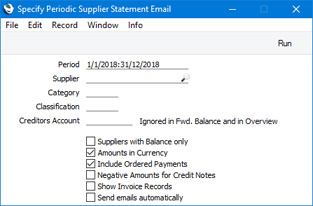Create Periodic Supplier Statement Email
This function will send
Periodic Supplier Statements to Suppliers by email. The function will create a separate Mail for each Supplier, as follows:
By default, the Mails created by this function will not be marked as Sent. So, you will have the opportunity to check and edit them. If necessary, however, you can have them marked as Sent immediately and automatically.
To send Mails to Suppliers using this function, you must be using the External Gateway module, and you must have configured the Email SMTP Server setting. Please refer here for full details about the mailing features in Standard ERP.
Selecting the function brings up the following dialogue box:

- Period
- Paste Special
Reporting Periods setting, System module
- Specify a period to be covered by the statements.
- Supplier
- Paste Special
Suppliers in Contact register
- Range Reporting Alpha
- If necessary, enter here the Supplier Number of the Supplier (or range of Suppliers) for whom you wish to send statements by email.
- Category
- Paste Special
Supplier Categories setting, Purchase Ledger
- If you want to send statements by email to Suppliers belonging to a particular Supplier Category, specify that Category here.
- Classification
- Paste Special
Contact Classifications setting, CRM module
- Enter a Classification Code in this field if you want to send statements by email to Suppliers with a certain Classification. If the field is empty, statements will be sent to all Suppliers, with and without Classifications. If you enter a number of Classifications separated by commas, statements will only be sent to those Suppliers featuring all the Classifications listed.
- Creditors Account
- Paste Special
Account register, Nominal Ledger/System module
- If you need the statements only to list the Purchase Invoices and Payments that post to a particular Creditor Account, specify that Account here.
- This field will not be used when calculating opening balance figures.
- Suppliers with Balance Only
- Check this box to exclude Suppliers with no current balance.
- Amounts in Currency
- Use this option to specify the Currency that will be used when printing some of the values in the statement.
- The following fields will print values in Currency or in Base Currency 1, depending on the option that you choose here: "Change during the Period", "Start Balance"; "Sum".
- The following fields will always print values in the Purch. Currency specified in the Contact record for the Supplier (in Base Currency 1 if the Purch. Currency is blank): "Account Balances".
- The following row fields will always print values in the currency of the transaction: "Balance"; "Credit Value, row"; "Debit Value, row"; "Invoice Amount"; "Received Value".
- Include Ordered Payments
- Use this option if you want to include Payments that have been Ordered but not marked as OK in statements.
- Show Invoice Records
- By default, transactions will be listed in chronological order in statements. For example, if you receive three Purchase Invoices from a Supplier and then pay all three, the statement will list the three Invoices followed by the Payments.
- If you use this option, Purchase Invoices will still be listed in chronological order, but the connected Payment(s) will follow immediately. In the example, a statement printed using this option will list the first Purchase Invoice followed by the corresponding Payment, then the second Purchase Invoice followed by its Payment and so on.
- Send emails automatically
- Choose this option if you would like the Mails created by this function to be marked as Sent automatically. If you are using the Lock and Send emails Automatically option in the Mail and Conference Settings setting in the Email and Conferences module, all Mails that are to be sent to external email addresses will be placed in the Email Queue immediately. This might be useful if the function creates many Mails but bear in mind that the Mails will be created without any Text so you might need to check and update the Mails before sending them. If you are not using the Lock and Send emails Automatically option, the Mails will be marked as Sent, but they will not be sent to the Email Queue. To do this, open each Mail and select 'Send email' from the Operations menu (Windows/Mac OS X) or Tools menu (iOS/Android).
When the specification window is complete, click (Windows/Mac OS X) or tap (iOS/Android) the [Run] button to activate the function. The relevant Mails will be created with statements attached, to be placed in your Mailbox (or the From System Mailbox). The Mails will be sent to the Email Queue and from there to the Suppliers as follows:
- If you chose the Send emails automatically option above and you are using the Lock and Send emails Automatically option in the Mail and Conference Settings setting, this will be done automatically and no further action is needed.
- If you chose the Send emails automatically option but you are not using the Lock and Send emails Automatically option, open each Mail in turn and select 'Send email' from the Operations menu (Windows/Mac OS X) or Tools menu (iOS/Android) to send it to the Email Queue.
- If you did not choose the Send emails automatically option but you are using the Lock and Send emails Automatically option, mark each Mail as Sent and save to send it to the Email Queue.
- If you did not choose the Send emails automatically option and you are not using the Lock and Send emails Automatically option, open each Mail in turn and select 'Send email' from the Operations or Tools menu to send it to the Email Queue. The Mail will be marked as Sent automatically.
---
Maintenance functions in the Purchase Ledger:
Go back to:
